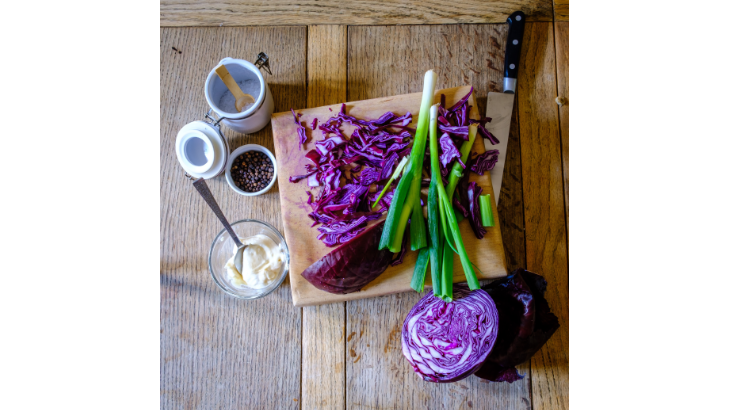Christmas Cabbages

About this time of year cabbages of every shape and size appear in the shops, and being mid-winter, we all need the vitamins and minerals they impart. What is more, they are inexpensive, and can be very versatile. If you really don’t know what to do with a cabbage, perhaps the following will help.
At the moment there’s a super red cabbage in our fridge, about the size of a bowling ball, very firm and with glossy purple outer leaves. Luckily it is big enough to allow for two different types of meal, since my significant other is a huge fan of coleslaw, whilst I am very enthusiastic about braised red cabbage.
Red Cabbage Coleslaw
Coleslaw, as purchased in the supermarket, consists largely of shredded white cabbage, grated carrot, onion and mayonnaise, but there are other incarnations of the dish (its name means simply “cabbage salad”). This is a variation on the traditional summer dish.
The appearance of any dish enhances its appeal, and thus our inclination to eat and enjoy it, so it’s important to get colour contrast into all food, as far as possible.
Grated carrot will fade into visual insignificance when mixed with red cabbage, and ideally another root veg, such as turnip or mooli, can be substituted. Turnips are rarely served raw in this country, but they have a similar flavour to radish, and will hold their own when mixed with the strong flavour of winter cabbage. If celeriac can be found – it is in season now - is also an excellent ingredient in red coleslaw. Onion is essential but can be hard to digest and it can “hang around” in much the same way as garlic. I overcome this problem by using either sweet shallots, which are mild in flavour, or spring onions. With red cabbage slaw, spring onions give added value, as the green of the leaves supplies the desired colour contrast.
Cut the cabbage into quarters, and cut out the core, which may be rather tough. If you like a finely chopped coleslaw, use the slicing tool on your food processor; if you prefer a coarser texture, use a very sharp knife and then slice each quarter as finely or roughly as you please. Grate the turnip or celeriac, and roughly chop the spring onions. Next add a good dollop of mayonnaise and then pep it up a bit with the addition of salad cream. Adjust quantities of mayo and salad cream to suit your preferred texture, season with salt and pepper if desired, et voilà! It’s all ready to serve!
Braised Red Cabbage
Braised red cabbage is a lovely robust dish with a vibrant colour; it goes well with any type of roast as well, I am told, with casseroles of game bird or venison. Below is one version, but of course there is more than one way to braise a cabbage.
Peel and chop one or two small onions and a clove of garlic. Slice the red cabbage finely (after coring) and rinse well in running water. Set aside to drain.
Warm a little sunflower or rapeseed oil in a large pan with a good thick base – the pan will need a close-fitting lid. Once the oil is warmed through, turn the heat right down and soften the chopped onions and crushed or chopped garlic. Shake off as much water from the drained cabbage as possible, then add it to the pan. Stir well to incorporate the onions and cabbage. Put the lid on the pan and return it to the low heat. Every now and again, stir the mix to make sure cooking is even, and prevent “catching” on the base of the pan.
While it is cooking, wash a medium sized orange, then remove the pan lid and zest the orange peel directly into the cabbage/onion mix. Stir well, replace lid and squeeze the juice of the orange, making sure to discard any pips, then add this to the pan, as well as a good dessertspoon of dark brown sugar. (Other sugars will do, if no muscovado on your shelves). By this point, the cabbage will be breaking down sufficiently to feel soft, but not soggy, and it’s important to give it the taste test. Add salt and pepper as required, and if you feel the dish needs a bit more bite to the flavour, add a dash of balsamic vinegar, and more brown sugar if needed. One of the beauties of braised red cabbage is that it can be stored in the fridge and microwaved when wanted. At a pinch, it can be frozen, though this may well affect the texture.
Bon appetit!
